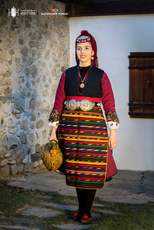Festive winter costume from Razlog- „aba“, typical for the second half of the XIX century
- Грозделина Георгиева-Саватинова
- Jul 14, 2021
- 4 min read
Updated: Nov 4, 2021
Numerous varieties of „saya” are stages of its development or local variants, dictated by natural conditions, textile raw materials, economic activity in the area and last but not least with the aesthetic taste of its wearers.

The names are different in different areas - „zabun”, „klashnik“, „anteriya”, but the characteristics of the „saya” are: long open front garment with long or short sleeves, rarely sleeveless. Made of smooth one-color or multicolored striped fabric with decoration on the bosom, sleeves and skirts of linear ornaments. In Razlog this is the most used winter garment in the 19th century. The „zabun” and the „klashnik“' are outerwear with similar patterns, but the „zabun” is more often with a sleeve. The contact with the Vlach culture influences the cut with the addition of more wedges, which expands its volume and silhouette. In later stages of its development, sleeves and fronts were sewn to it. After the old klashnik fell out of use, the role of outer garment was taken by the burgundy "kopanar". Over time, the „kopanar” moves further and further away from its prototype and undergoes changes in cut, pattern and decoration.
In Razlog it is better known as „zabun”. It is sewn from litho woven fabric in "kurmuzov" (red) color, it can be cut from white, blue, red and yellow threads at the base. The lining is white, cotton, lightly quilted and tiled. Usually without sleeves at work, but for livery sleeves are added, which makes an undergarment under the „aba”. Inverted covers on the sleeves are hemmed with a patterned fabric.
This outerwear almost completely covers the shirt, as it becomes entirely in underwear and in some of the parts has a reduction of the decoration. Locals call it a „koshulya” (shirt), which is completely decorated with colored stripes, which are visible through the lateral processes of the upper cloth. This „koshulya” has a “zapeski” from Razlog.


The blue aba (siniovitsa) is considered to be an improved and slightly later version of the white “klashnik” because it is the result of the development of the painting craft and the bringing of indigo (blue) by trade. The “aba” is sleeveless - on “ramushki”. If worn at the same time as the “klashnik”, it becomes an undergarment and the “aba” an outer garment. It is worn when going out "in front of people”: at church or at a visiting. It is made of thick “tepana”, woolen fabric with a light blue or black braid trim at the edges. Elongated and widened so that it can be worn "on opretulyakya"- with skirts folded back, the tops of which meet at the back of the waist and are fastened with a girdle or apron belt. So the style of wearing the “aba” brings mobility to the composition of the suit and allows to see the beauty of the outer garment - “zabun”, “anteriya”. The gridle (scarlet) keeps the fronts facing backwards, but also belts and tightens the woman's waist. An apron called “badame” is tied on it, which is usually in diamonds of different colors. At the top is put beaded belt fastened with large round silver buckles.

On the head the woman wears a small hat with a sewn-on silver plate (tepelak) with coins hanging on it. This bridal jewelry is worn for some time after the wedding, while the bride is still "fasting" (keeps a ritual silence). The silver or gilded plates are placed on the top, where their name comes from - “tepelatsi” , and the additional metal or bead decorations strengthen the protective function by deflecting the "evil eyes". It is believed that the “tepelatsi” protects the woman's fontanelle, because from the birth of a human it is the open soft part of the skull, through which it can receive the Divine energy, but also the negative one. The hat is covered with a burgundy “sindzhirliya” with a decoration of roses. After marriage, women for a period of time continued to wear the ritual parts of their clothing and jewelry (earrings, necklaces, buckles) when going out, one to show their new marital status and the second to be protected while giving birth to bad thoughts and “uroki”.

The feet are covered with brown or white knitted socks with embroidered flowers on the ankles and feet and with Wallachian slippers. This is a costume that was worn on Babinden in Razlog.
Borislava Kutlarska from Razlog put on the costume.
The costumes from the fund of the Historical Museum - Razlog.
The project "Study of the specifics and richness of national costumes from the Razlog region in the light of cultural diversity" is realized with the financial support of the National Culture Fund under the program "Cultural Heritage".
In fulfillment of the goals of the project we present some of the most beautiful traditional costumes, typical for the Razlog valley in the last 2 centuries.
We offer our sincere thanks to our hosts from the Historical Museum - Razlog, and to all local people who helped with the realization.
Special thanks to all participants and team members who took their time and with useful information, knowledge and valuable advice made possible the work on the project.
A reverence to the girls and boys from the town of Razlog, who stood in front of our camera and with their enthusiasm, youth and beauty revived for a new life the most beautiful costumes from old Mehomiya.























Comments